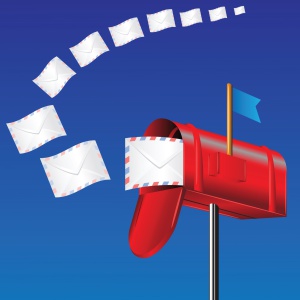I was recently doing some testing of IE9′s Site Pinning API and found out about a cool bit of functionality that can enhance user notifications. If you’re not familiar with site pinning, it’s a great way to allow users to have easy and quick access to their favorite sites via the Windows taskbar. There’s a really nice overview of it on BuildMyPinnedSite.com that explains how it works, and Sitepoint has previously published some good coverage here, here and here.
Keeping Users Up-to-Date
One of the features the API provides is notifications that can allow developers to provide alerts to end users. The functionality allows you to dynamically insert custom overlay icons that can alert users when an important bit of information is available. These overlay icons are rendered over the favicon that is pinned to the taskbar. If you look at the image below, you can see it in action:

Pinned site with no overlay icon

Pinned site with overlay icon
So if you think about the possibilities, any site that offers users an inbox, special deals or sends out time-sensitive alerts could use this notification capability to keep their users up-to-date and more engaged on the site. Sites like the Huffington Post have already discovered that users that pinned HuffPost spent 49% more time on the site.
The best part is that adding this capability is insanely easy.
Setting it Up
For this post, we’re not going to go into the basics of how to pin a site. If you want to learn more, here’s a GREAT resource for getting you up to speed quickly: BuildMyPinnedSite.com. In fact, I used that site to help get me up-to-speed on the basics and it’s well-worth visiting.
To add notifications, you’ll need a couple of things:
- A cool favicon for your site. If you don’t have one, you can use the handy web-based X-Icon Editor to create one.
- A set of overlay icons to use. The recommended size is 16×16.
The API is JavaScript-based and we’ll use the following methods:
window.external.msSiteModeClearIconOverlay()
window.external.msSiteModeSetIconOverlay()
window.external.msSiteModeActivate()
window.external.msIsSiteMode()
The window.external.msSiteModeClearIconOverlay method is used to clear out any previously set overlay icons. window.external.msSiteModeSetIconOverlay allows you to specify the name of the notification icon as well as an accessible description. We’ll use window.external.msSiteModeActivate to flash the pinned icon to notify the user of the update. Lastly, window.external.msIsSiteMode will let us know if the page was launched as a pinned site, thus allowing us to better determine when to run the code.
For the overlay icons, I’m using five images that display numbers 1 through 5 respectively to designate the number of messages are in a user’s inbox.
The Code
The first thing I need to add is the reference to my favicon. Note that if you don’t add one, Internet Explorer’s icon will be used by default.
<link rel="shortcut icon" type="image/ico" href="favicon.ico" />
Next, I want to create some sample data to work with. What I want to do for my demo is have the overlay icon dynamically change every 5 seconds to simulate a more real-world scenario. The data is a simple array containing JSON data in each element.
myPin.init([{ "num": 1, "label": "Label 1" },
{ "num": 2, "label": "Label 2" },
{ "num": 3, "label": "Label 3" },
{ "num": 4, "label": "Label 4" },
{ "num": 5, "label": "Label 5" }
]);
By setting a timer, I’ll be able to pull a new set of data every 5 seconds.
setInterval(function () { myPin.getData(); }, 5000);
The main thing to keep in mind is that I’m “simulating” getting data from some remote host. In reality, all that the myPin.getData() method does is use a running counter to grab a new set of data and render a new overlay icon:
getData: function () {
// A function that just simulates returning a result set...
var idx = 0;
// Determines whether the current page was launched as a pinned site.
if (window.external.msIsSiteMode()) {
idx = this.currIndex++;
this.currIndex = (this.currIndex < 5) ? this.currIndex : 0;
this.dispOverlay(this.dataBin[idx]);
}
}
As you can see, it uses the running counter var currIndex to determine which array element to grab and then passes the data to dispOverlay(). This is where we use window.external.msSiteModeClearIconOverlay() to clear out any previously displayed overlay icons and also generate a string for the actual icon name. You can see that the oImg var is created on the fly based on the data we’re using.
dispOverlay: function (theData) {
var oImg = "";
// Is there any data?
if (theData) {
// Clear any preexisting overlay icon
window.external.msSiteModeClearIconOverlay();
// Create the image string...
oImg = "images/num_" + theData.num + ".ico";
// Go ahead and create the overlay image and it's label...
this.setOverlay(oImg, theData.label);
}
}
That icon name, along with the accessible label text for the icon, is passed to setOverlay() which sets the overlay icon via window.external.msSiteModeSetIconOverlay and flashes the taskbar icon using window.external.msSiteModeActivate.
setOverlay: function (icon, desc) {
// Sets the overlay icons...
window.external.msSiteModeSetIconOverlay(icon, desc);
window.external.msSiteModeActivate();
}
Test it Out
To test this out, it’s a simple matter of running your newly pinned page in Internet Explorer 9, grabbing the tab and dragging it down to your taskbar:

Tab being dragged to the taskbar

Pinned site with no overlay icon
Five seconds after the page has been pinned, the code will fire off the first notification and continue to cycle through the other icons every subsequent five seconds.

Pinned site with overlay icon
An important thing to remember is that the IE F12 Developer tools are available to you to use in debugging your pinned site. So if you run into quirks, simply press the F12 key and the tools will appear.

The Demo and Final Code
You can check out the demo I whipped up by going here in IE9:
http://reybango.com/demos/sitepinning/index.html
When the page renders, drag the tab down to your taskbar and pin it. You should see a new windows appear with your newly pinned site. Five seconds later, you’ll see the first overlay icon appear in the taskbar.
Here’s the full source code. You can also download everything here. The really great part is that it isn’t a lot of code to implement this. In fact, to use the API only required 4 method calls. The bulk of the code was to simulate pulling in data. And the impact on user engagement is certainly worth adding in the capability.
<!DOCTYPE html> <html> <head> <title>Pinned Site Test</title> <link rel="shortcut icon" type="image/ico" href="favicon.ico" /> <meta name="application-name" content="Pinned Site Test" /> <meta name="msapplication-starturl" content="http://reybango.com/demos/sitepinning/index.html" /> <meta name="msapplication-navbutton-color" content="#3480C0" /> <meta name="msapplication-window" content="width=1024;height=768" /> <meta name="msapplication-tooltip" content="Testing the Pinned Site API" /> <style> body { background: none repeat scroll 0 0 #4492CE; color: #EDEFF4; } h1 { float: left; font: 440%/1.4em 'Segoe Light',Segoe,'Segoe UI','Meiryo Regular','Meiryo',sans-serif; margin-left: 10px; position: relative; } </style> </head> <body> <h1>Pinned Site Test</h1> <div></div> <script> var myPin = { currIndex: 0, dataBin: [], getData: function () { // A function that just simulates returning a result set... var idx = 0; // Determines whether the current page was launched as a pinned site. if (window.external.msIsSiteMode()) { idx = this.currIndex++; this.currIndex = (this.currIndex < 5) ? this.currIndex : 0; this.dispOverlay(this.dataBin[idx]); } }, setOverlay: function (icon, desc) { // Sets the overlay icons... window.external.msSiteModeSetIconOverlay(icon, desc); window.external.msSiteModeActivate(); }, dispOverlay: function (theData) { var oImg = ""; // Is there any data? if (theData) { // Clear any preexisting overlay icon window.external.msSiteModeClearIconOverlay(); // Create the image string... oImg = "images/num_" + theData.num + ".ico"; // Go ahead and create the overlay image and its label... this.setOverlay(oImg, theData.label); } }, init: function (myData) { this.dataBin = myData; } }; // This clears out any previously set overlay icons... window.external.msSiteModeClearIconOverlay(); // Run it once to kick everything off... myPin.init([{ "num": 1, "label": "Label 1" }, { "num": 2, "label": "Label 2" }, { "num": 3, "label": "Label 3" }, { "num": 4, "label": "Label 4" }, { "num": 5, "label": "Label 5" } ]); // This is only here because I want to simulate pulling data on a regular interval... setInterval(function () { myPin.getData(); }, 5000); </script> </body> </html>
This article was originally published by the author. It is republished, with slight modifications, with permission.
 Rey Bango
Rey BangoAs a Technical Evangelist for Microsoft, Rey focuses on promoting best practices for client-side web development and helping Microsoft meet the needs of this community. He is passionate about HTML5 and the possibilities that it brings for building rich, interactive web applications. In addition, Rey is a member of the jQuery JavaScript project team, and writer for .net magazine.





